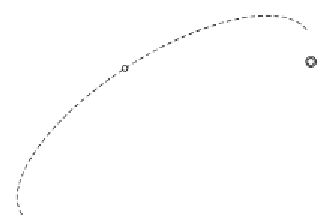Geoscience Reference
In-Depth Information
Z
0
K'
S
line of nodes
À
P
A
!
i
vernal equinox
K
X
0
Fig. 7.2. Satellite orbit as projected onto a unit sphere
by
Kepler's three laws for planetary motion
. Satellites with parabolic or
hyperbolic orbits are of no interest in this context.
According to
Kepler's first law
, the orbit is an ellipse of which the center
of the earth occupies one focus. The position of the orbit in space is defined
by the six
orbital elements
:
a
semimajor axis,
e
eccentricity,
i
inclination,
(7-3)
Ω
right ascension of the node,
ω
argument of perigee,
T
time of perigee passage
.
If
a
and
b
are the semiaxes of the orbital ellipse (there is no danger of
confusion with those of the terrestrial ellipsoid!), then the eccentricity is
defined by
e
=
√
a
2
− b
2
a
.
(7-4)
Figure 7.2 shows the projection of the orbit onto a geocentric unit sphere,
where
P
is the perigee,
A
the apogee,
K
is the ascending node,
K
the
descending node,
S
is the instantaneous position of satellite. The line of
nodes is the intersection of the orbital plane with the plane of the equator;
it connects the ascending node
K
and the descending node
K
.Theright
ascension of the node, Ω, is the angle between the line of nodes and the
direction to the vernal equinox. The symbol Ω is also called longitude of










